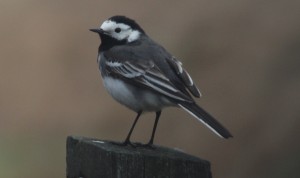 Urban birds, excluding gardens, include a wide variety of birds such as feral pigeons, some call them feral doves, carrion and hooded crows, herring gulls and jackdaws etc. One surprising bird is much smaller than these, the pied wagtail, that now often frequents roads and car parks. Only last week for example I parked in a large car park in a supermarket in the centre of Inverness and there trotting around was a pied wagtail. If a vehicle or person was in the way, a short flight of only a few feet and down the bird went again to find food. The jerky walk is accentuated by the ever bobbing tail that has posed a mystery for many years. Some say the bobbing tail is to disturb small insects whilst other people say it helps to keep the bird on balance as it is constantly on the move. Perhaps it was these characteristics that made the Northamptonshire poet John Clare to pen the poem “Little Trotty Wagtail” he wrote in 1855. “Little trotty wagtail, he went in the rain, / And tittering, tottering sideways he ne’er got straight again, / He stooped to get a worm, and looked up to catch a fly, / And then he flew away ere his feathers they were dry”.
Urban birds, excluding gardens, include a wide variety of birds such as feral pigeons, some call them feral doves, carrion and hooded crows, herring gulls and jackdaws etc. One surprising bird is much smaller than these, the pied wagtail, that now often frequents roads and car parks. Only last week for example I parked in a large car park in a supermarket in the centre of Inverness and there trotting around was a pied wagtail. If a vehicle or person was in the way, a short flight of only a few feet and down the bird went again to find food. The jerky walk is accentuated by the ever bobbing tail that has posed a mystery for many years. Some say the bobbing tail is to disturb small insects whilst other people say it helps to keep the bird on balance as it is constantly on the move. Perhaps it was these characteristics that made the Northamptonshire poet John Clare to pen the poem “Little Trotty Wagtail” he wrote in 1855. “Little trotty wagtail, he went in the rain, / And tittering, tottering sideways he ne’er got straight again, / He stooped to get a worm, and looked up to catch a fly, / And then he flew away ere his feathers they were dry”.
This year pied wagtails have been surprising visitors to our garden as a pair are regularly feeding underneath the bird feeders. Whilst their normal food is insects, especially flies and midges and also caterpillars in the garden, they must be taking tiny pieces from under the feeders. The feeders have a range of food such as nyger, peanuts, sunflower hearts, mixed grain and suet. When other birds from titmice to greenfinches feed on these they inevitably scatter small pieces on the ground below and this is what the pied wagtails must be after. As for where the pair are nesting it seems that a likely place is on a wall along the narrow road outside the house. There are three pairs along this stretch of wall and the nest is in between the stones. What is always amazing is that in such situations the birds never seem to be hit by any vehicles and I can never remember seeing such a casualty.
Last year there was another surprise with a pair of pied wagtails as I had erected two artificial nestboxes just outside the garage under the eaves. The idea was to see if swallows might nest there. As it happened a pair of pied wagtails nested there despite the presence of a vehicle, used every day, underneath the nest. Interestingly they raised a second brood in the same nest. When the five or six eggs were being incubated, both male and female share this task and it was fascinating to see the bird peering out as I went into the car and drove off and then back later. The young were fed by both adults and after the eggs hatched it was just 14 days before they flew successfully. Outside the breeding season the pied wagtails are normally solitary and the male will defend territory. However, they have one intriguing winter habit in that they will sometimes gather in large numbers to roost. These communal roosts may number dozens of birds but hundreds have been recorded which must be a very impressive sight and they are sometimes in urban areas. Very large numbers breed in Scotland with the latest estimate being around 100,000 pairs which seems to be stable or possibly increasing in numbers
Tags: highland wildlife
